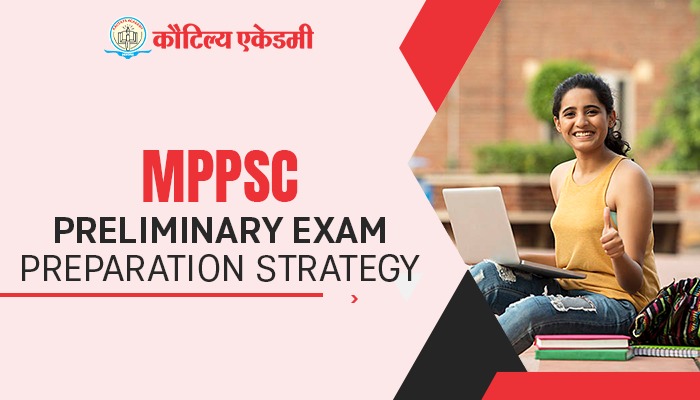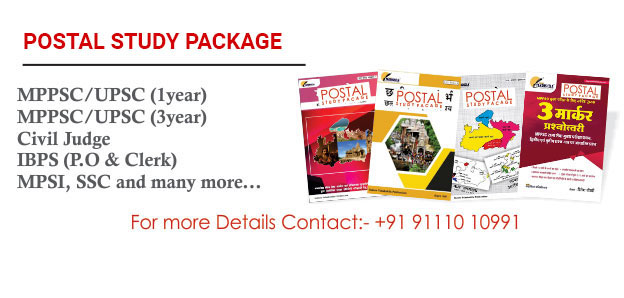MPPSC Preliminary Exam Preparation Strategy
Kautilya Academy 27-11-2020

MPPSC Preliminary Exam Preparation Strategy
Today in this blog, you will get to know about how to design your own strategy for preparation as per the distinct demands of different subjects.
There are two kinds of questions asked in MPPSC examination, one from the traditional sections of general studies and the other from current affairs. The questions asked from traditional sections are mainly the history and independence movement of India; Indian Constitution and Polity; Geography of India and the world; Ecology, Environment and Biodiversity; Indian Economy, Economic and Social Development; Are related to general science. Also, questions related to current events of national and international importance are also asked in this paper.
Let us first know the Exam pattern of MPPSC 2020-21.
Exam Pattern and Strategy for MPPSC Prelims 2020
|
Paper |
Subjects |
Duration of Exam |
Marks |
|
Paper I |
General Studies |
2 hours |
200 marks |
|
Paper II |
General Aptitude Test (Qualifying) |
2 hours |
200 marks |
Core Subjects and preparation mechanics
1. History and Culture
History is more or less theoretical rather than conceptual. Sometimes students face controversies in dates and other facts, to avoid this a candidate should follow a single or a particular source which he thinks its authentic or understood better rather than following several books which creates confusion. Special emphasis should be laid upon date/year of incidences, establishments or foundation of any organization or heritage, chronology and mapping to understand the happenings and cause in a better way. Each year nearly 10-20 questions are covered from History section with extra weightage of Modern history.
2. World and Indian Geography
Geography is a conceptual subject. There is a reason behind all the happenings in this universe. A candidate must have to understand the major geological, geomorphological, meteorological, oceanographical and environmental concepts in both spatial and temporal manner so as to comprehend the phenomena. Without deep comprehension candidate could not be able to grasp the facts. Each year nearly 10-15 questions are covered from geography with special weightage to Geography of India.
3. Indian Polity and Governance
Polity and Governance is a dynamic subject. A candidate needs to be updated with latest amendments, changes and relevant scenario for efficient understanding. Society also plays an important role in polity and governance; hence you must develop a societal trait and ideology for actual analyzation and demands along with the existing laws and government structure. Basic understanding of preamble and structure of Indian constitution is must.
Candidates should follow up the government reports, amendments, and recent updates from official websites of government along-with standard books.
Polity and Governance covers nearly 15-20 questions specially from current affairs section.
4. Economics
Maximum number of students face hardships in understanding the concept of economics but you have to give equal weightage to each and every core subject whether it is easy or tough. A candidate must have a clear-cut concept of GDP, GNP, PCI and the basic terminologies and definitions. Economy section covers 08-12 questions.
5. General science and Environment
Each year nearly 08-10 questions are covered from Environment with reference to Current affairs and from some relevant traditional topics.
6. Current Affairs and sports
10-15 questions are covered from Current affairs, awards, and events. You must remain updated with Current affairs section as much of the static portion is also somewhere interlinked with current events.
7. Madhya Pradesh GK
As you all are aware about the MPPSC exam pattern, it has a large weightage of MP specific questions. A candidate must have a good understanding of physiography, history, polity and economy of the state. Questions – near about 10-15.
CSAT Preparation Strategy
ü Ever since the CSAT question paper has been qualifying in nature in the preliminary examination, many candidates have almost ceased to study the CSAT and have put all their energy and efforts into preparing for general studies. This is not done. Remember that CSAT has been made qualifying, not removed from the examination. It is not at all easy to get minimum 33% marks to qualify in the CSAT question paper.
ü Not all candidates can have same approach for preparing for CSAT. For some candidates whose background is in Mathematics and Science subjects, it is not a difficult task to solve 27 questions in two hours by combining Mathematics and Reasoning section, while for students of humanities background it is difficult to cross this data at times.
ü It is worth noting that a total of 80 questions are asked in the CSAT question paper, in which each question carries 2.5 marks. In this way, to get the 33% marks prescribed for qualifying in CSAT, you are required to get 66 out of 200 marks. Keep in mind that negative marking is applicable in CSAT also.
ü If one has a good grasp of mathematics and reasoning, one feels comfortable in solving comprehension. By analyzing the questions asked from various sections in the last 6 years, it can be concluded that now it would be more appropriate to pay attention to which sections in the CSAT and which are not particularly harmful even after leaving them.
ü The 'CSAT' paper mainly consists of comprehension, interpersonal skills including communication skills, logical skills and analytical ability, judgment and mark-solving and problem-solving, Questions related to general mental ability, basic numeracy and data interpretation (high school level) are asked.
Preparation Strategy through Notes for MPPSC Prelims
v Analyzing complete syllabus should be the foremost part of preparation
v Emphasis on each topic discretely to get uniformity.
v Essence of multiple sources
v Simple and abstract information
v Don’t be superlative in modification
v Include examples in your notes
v Use of Maps, Diagrams, Flow charts and Symbols
v Stay updated with current affairs and contemporary events
v Use loose paper sheets so that it becomes easy to add/update the notes.
v The topic wise notes on this website are prepared with expertise for your convenience.




